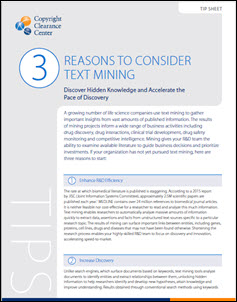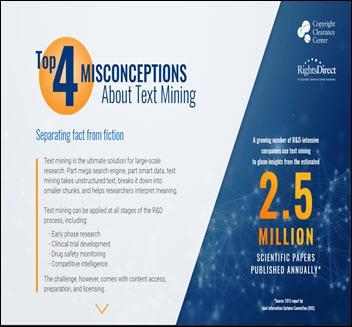A growing number of life science companies use text mining to gather important insights from vast amounts of published information. The results of mining projects inform a wide range of business activities including drug discovery, drug interactions, clinical trial development, drug safety monitoring and competitive intelligence. Download the new Copyright Clearance Center white paper that covers three of the top reasons to consider implementing text mining for life sciences companies.
Top 4 Misconceptions About Text Mining
Text mining is the ultimate solution for large-scale research. Part mega search engine, part smart data, text mining takes unstructured text, breaks it down into smaller chunks, and helps researchers interpret meaning. Check out the e-book from the Copyright Clearance Center that covers four misconceptions about text mining, as well as the “reality” of each of these situations.
The Downside of Converting Full-Text PDFs to XML for Text Mining
To get the best results from text mining projects, researchers need access to full-text articles. However, when researchers obtain full-text articles through company subscriptions or document delivery, the documents are often provided as PDFs, a suboptimal format for use with text mining software. The burden is then on researchers to convert the PDFs to XML. But that can be inefficient and costly. Read on as Michael Iarrobino, Product Manager at Copyright Clearance Center, explains the pitfalls of converting full-text PDFs to XML for text mining.
Key Challenges for Commercial Text Miners
Researchers use text mining tools to extract and interpret facts, assertions, and relationships from vast amounts of published information. Mining accelerates the research process. However, despite the many benefits of text mining, researchers face a number of obstacles before they even get a chance to run queries against the bigger body of literature. Read on as Michael Iarrobino, Product Manager at Copyright Clearance Center, explains the key challenges for commercial text miners.
The Advantages of Mining Full-Text Articles over Abstracts
Given their easy accessibility, many researchers use article abstracts to identify a collection of articles for use in text mining. But, while abstracts provide some valuable pieces of information, there are major advantages to taking steps using and mining full-text articles instead. Read on as Michael Iarrobino, Product Manager at Copyright Clearance Center, explains the advantages of mining full-text articles over abstracts.
The Downside of Converting Full-Text PDFs to XML for Text Mining
One major challenge when converting PDFs to full-text for mining is diminished data integrity. The conversion process can introduce errors (e.g., poor character recognition for uncommon fonts) and often removes tags that indicate sections of the article, such as introduction, conclusion, and materials and methods, making the corpus difficult to mine.
The Advantages of Mining Full-Text Articles over Abstracts
Text mining enables the rapid review and analysis of large volumes of biomedical literature, giving life science companies valuable insights to drive research and development and inform business decisions. For example, the results of mining projects can provide a greater understanding of the underlying biology behind specific diseases and how they respond to certain drugs, and support the target discovery process.
Key Challenges for Commercial Text Miners
In biomedical research and development, researchers use text mining tools to extract and interpret facts, assertions, and relationships from vast amounts of published information. Mining accelerates the research process, increases discovery of novel findings, and helps companies identify potential safety issues in the drug development process. However, despite the many benefits of text mining, researchers face a number of obstacles before they even get a chance to run queries against the body of biomedical literature.







